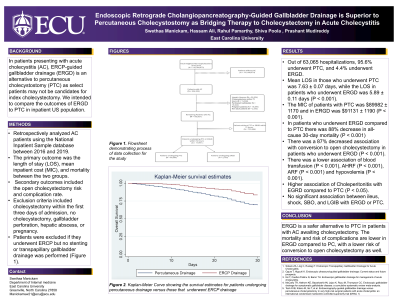Back


Poster Session C - Monday Afternoon
Category: Interventional Endoscopy
C0450 - Endoscopic Retrograde Cholangiopancreatography-Guided Gallbladder Drainage Is a Better Alternative to Percutaneous Cholecystostomy as Bridging Therapy to Cholecystectomy in Acute Cholecystitis
Monday, October 24, 2022
3:00 PM – 5:00 PM ET
Location: Crown Ballroom

Has Audio

Swethaa Manickam, MD
East Carolina University
Greenville, NC
Presenting Author(s)
Swethaa Manickam, MD1, Hassam Ali, MD1, Rahul Pamarthy, MD1, Shiva Poola, MD2, Prashant Mudireddy, MD1
1East Carolina University, Greenville, NC; 2ECU Health Medical Center/Brody School of Medicine, Greenville, NC
Introduction: In patients presenting with acute cholecystitis (AC), ERCP-guided gallbladder drainage (ERGD) is an alternative to percutaneous cholecystostomy (PTC) as select patients may not be candidates for index cholecystectomy. We intended to compare the outcomes of ERGD to PTC in inpatient US population.
Methods: We retrospectively analyzed AC patients using the National Inpatient Sample database between 2016 and 2019. The primary outcome was the length of stay (LOS), mean inpatient cost (MIC), and mortality between the two groups. Secondary outcomes included the open cholecystectomy risk and complication rate. Exclusion criteria included cholecystectomy within the first three days of admission, no cholecystectomy, gallbladder perforation, hepatic abscess, or pregnancy. Additionally, patient were excluded if they underwent ERCP but no stenting or transpapillary gallbladder drainage was performed (Figure 1).
Results: Out of 63,065 weighted hospitalizations, 95.6% underwent PTC, and 4.4% underwent ERGD. The mean length of stay in patients who underwent PTC was 7.63 ± 0.07 days, while the length of stay in patients who underwent ERGD was 5.89 ± 0.11 days (P < 0.001). The MIC of patients with PTC was $89982 ± 1170 and in ERGD was $91131 ± 1190 (P < 0.001). (P < 0.001).
There was a 88% decreased risk with all-cause 30-day mortality in patients who underwent ERGD compared to PTC (HRadj 0.31, [95% CI 0.10-0.59], P < 0.001) (Figure 2). There was a 87% decreased association with conversion to open cholecystectomy in patients who underwent ERGD compared to PTC (AOR 0. 13, [95% CI 0.10 -0.38], P < 0.001). There was a lower association of blood transfusion (AOR 0.31 , [95% CI 0.16 -0.59], P < 0.001), AHRF (AOR 0.37, [95% CI 0.26-0.52], P < 0.001), ARF (AOR 0.48 , [95% CI 0.38 -0.59], P < 0.001) and hypovolemia (AOR 0.61, [95% CI 0.45-0.83], P < 0.001). There was a higher association of Choleperitonitis with EGRD compared to PTC (AOR 3.3, [95% CI 1.04 -10.5], P < 0.05). There was no significant association between ileus, shock, SBO, and LGIB with ERGD or PTC.
Discussion: ERGD is a safer alternative to PTC in patients with AC awaiting cholecystectomy. The mortality and risk of complications are lower in ERGD compared to PC, with a lower risk of conversion to open cholecystectomy as well.

Disclosures:
Swethaa Manickam, MD1, Hassam Ali, MD1, Rahul Pamarthy, MD1, Shiva Poola, MD2, Prashant Mudireddy, MD1. C0450 - Endoscopic Retrograde Cholangiopancreatography-Guided Gallbladder Drainage Is a Better Alternative to Percutaneous Cholecystostomy as Bridging Therapy to Cholecystectomy in Acute Cholecystitis, ACG 2022 Annual Scientific Meeting Abstracts. Charlotte, NC: American College of Gastroenterology.
1East Carolina University, Greenville, NC; 2ECU Health Medical Center/Brody School of Medicine, Greenville, NC
Introduction: In patients presenting with acute cholecystitis (AC), ERCP-guided gallbladder drainage (ERGD) is an alternative to percutaneous cholecystostomy (PTC) as select patients may not be candidates for index cholecystectomy. We intended to compare the outcomes of ERGD to PTC in inpatient US population.
Methods: We retrospectively analyzed AC patients using the National Inpatient Sample database between 2016 and 2019. The primary outcome was the length of stay (LOS), mean inpatient cost (MIC), and mortality between the two groups. Secondary outcomes included the open cholecystectomy risk and complication rate. Exclusion criteria included cholecystectomy within the first three days of admission, no cholecystectomy, gallbladder perforation, hepatic abscess, or pregnancy. Additionally, patient were excluded if they underwent ERCP but no stenting or transpapillary gallbladder drainage was performed (Figure 1).
Results: Out of 63,065 weighted hospitalizations, 95.6% underwent PTC, and 4.4% underwent ERGD. The mean length of stay in patients who underwent PTC was 7.63 ± 0.07 days, while the length of stay in patients who underwent ERGD was 5.89 ± 0.11 days (P < 0.001). The MIC of patients with PTC was $89982 ± 1170 and in ERGD was $91131 ± 1190 (P < 0.001). (P < 0.001).
There was a 88% decreased risk with all-cause 30-day mortality in patients who underwent ERGD compared to PTC (HRadj 0.31, [95% CI 0.10-0.59], P < 0.001) (Figure 2). There was a 87% decreased association with conversion to open cholecystectomy in patients who underwent ERGD compared to PTC (AOR 0. 13, [95% CI 0.10 -0.38], P < 0.001). There was a lower association of blood transfusion (AOR 0.31 , [95% CI 0.16 -0.59], P < 0.001), AHRF (AOR 0.37, [95% CI 0.26-0.52], P < 0.001), ARF (AOR 0.48 , [95% CI 0.38 -0.59], P < 0.001) and hypovolemia (AOR 0.61, [95% CI 0.45-0.83], P < 0.001). There was a higher association of Choleperitonitis with EGRD compared to PTC (AOR 3.3, [95% CI 1.04 -10.5], P < 0.05). There was no significant association between ileus, shock, SBO, and LGIB with ERGD or PTC.
Discussion: ERGD is a safer alternative to PTC in patients with AC awaiting cholecystectomy. The mortality and risk of complications are lower in ERGD compared to PC, with a lower risk of conversion to open cholecystectomy as well.

Figure: Figure 1: Flowsheet for data selection
Figure 2: Kaplan Meier Survival Estimates for patients undergoing ERCP guided gallbladder drainage compared to Percutaneous drainage for Acute cholecystitis.
Figure 2: Kaplan Meier Survival Estimates for patients undergoing ERCP guided gallbladder drainage compared to Percutaneous drainage for Acute cholecystitis.
Disclosures:
Swethaa Manickam indicated no relevant financial relationships.
Hassam Ali indicated no relevant financial relationships.
Rahul Pamarthy indicated no relevant financial relationships.
Shiva Poola indicated no relevant financial relationships.
Prashant Mudireddy indicated no relevant financial relationships.
Swethaa Manickam, MD1, Hassam Ali, MD1, Rahul Pamarthy, MD1, Shiva Poola, MD2, Prashant Mudireddy, MD1. C0450 - Endoscopic Retrograde Cholangiopancreatography-Guided Gallbladder Drainage Is a Better Alternative to Percutaneous Cholecystostomy as Bridging Therapy to Cholecystectomy in Acute Cholecystitis, ACG 2022 Annual Scientific Meeting Abstracts. Charlotte, NC: American College of Gastroenterology.
